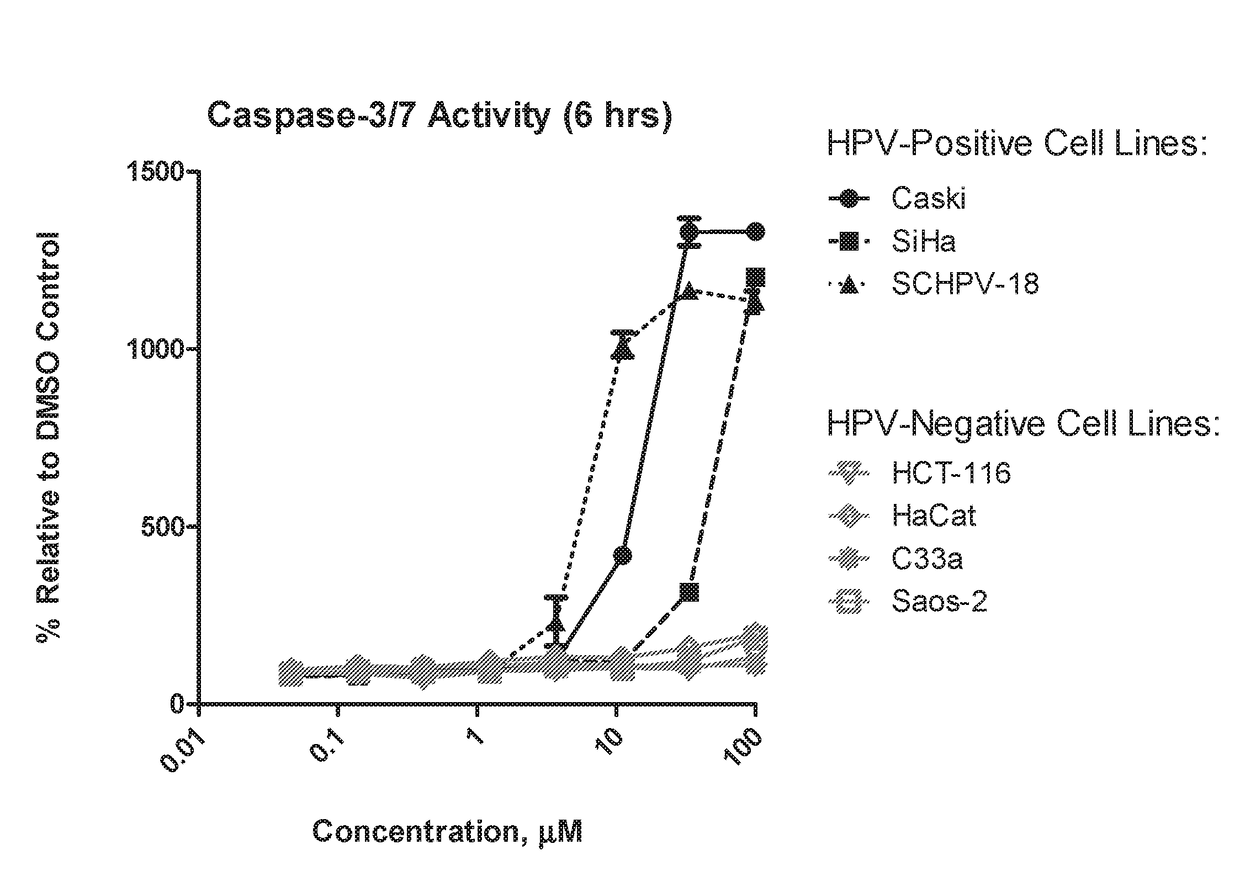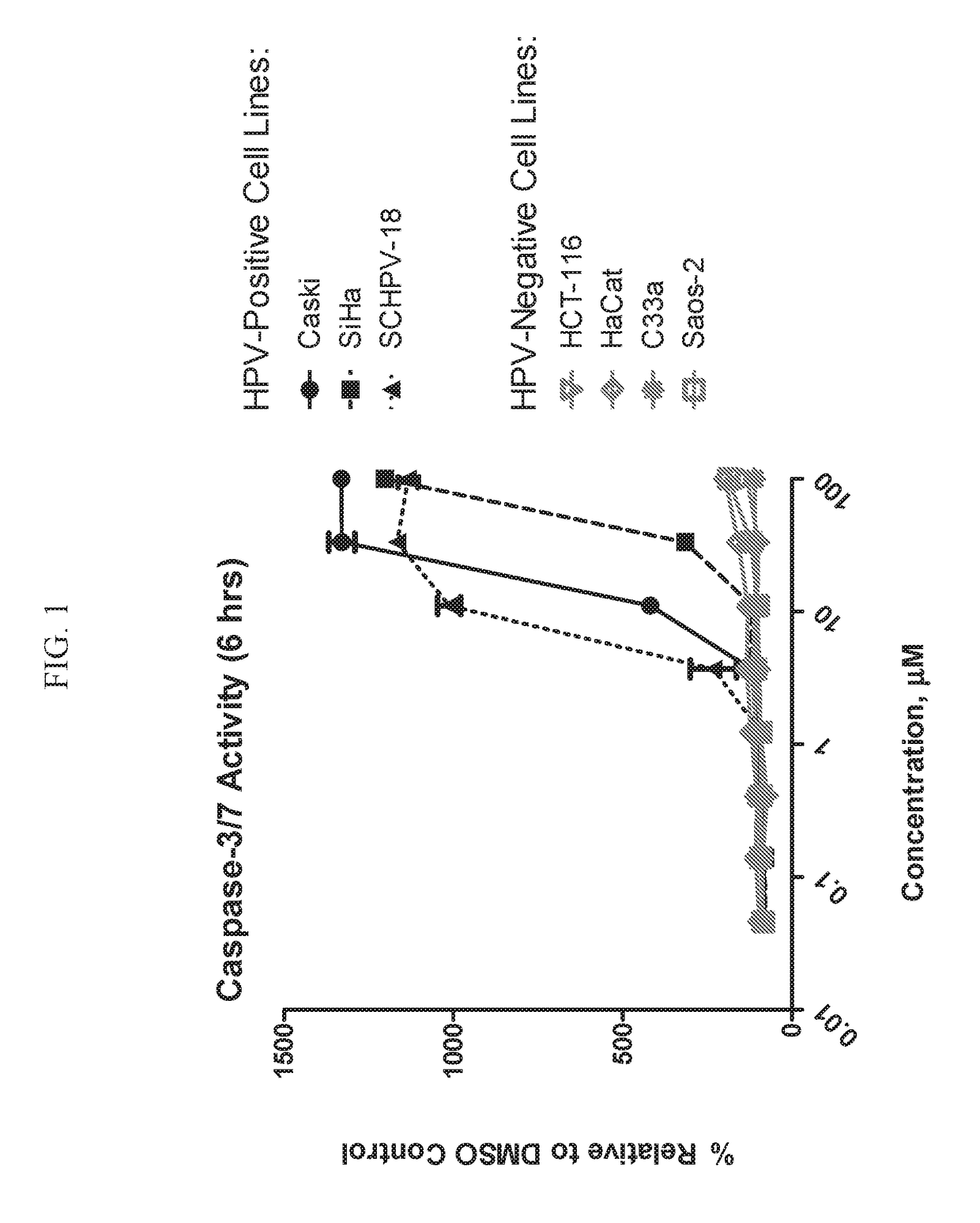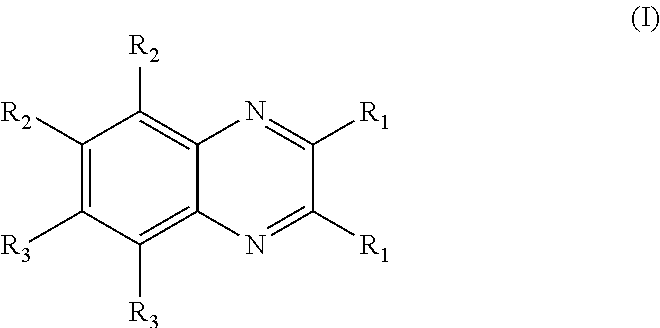Aryl substituted bicyclic heteroaryl compounds
a technology of bicyclic heteroaryl and compound, applied in the field of aryl substituted heteroaryl compounds, can solve the problems of increased risk of bleeding as well as partial efficacy, vaccines are not effective as cervical cancer therapeutics, and the rate of cervical cancer is reduced. , the effect of poor uptake of vaccines
- Summary
- Abstract
- Description
- Claims
- Application Information
AI Technical Summary
Benefits of technology
Problems solved by technology
Method used
Image
Examples
example 1
[0260]A mixture of Intermediate 1D (37 mg, 0.097 mmol), zinc cyanide (6.84 mg, 0.058 mmol), palladium (II) trifluoroacetate (2.58 mg, 7.77 μmol) and zinc dust (1.269 mg, 0.019 mmol) in DMA (1.0 mL) was degassed by bubbling argon for 5 min. Then racemic-2-(di-tert-butylphosphino)-1,1′-binaphthyl (6.19 mg, 0.016 mmol) was added. The reaction vessel was sealed, stirred at room temperature for 10 min and heated at 90° C. overnight. The reaction mixture was diluted with EtOAc / saturated sodium bicarbonate. The insoluble was removed by filtration. The filtrate was collected, organic layer was washed with brine, dried over sodium sulfate. After evaporation of solvent, the crude residue was purified using a preparative HPLC (method A, 40-100% B in 10 min; with a flow rate of 40 mL / min). The desired fractions were concentrated and lyophilized to give Example 1 (16 mg, 0.047 mmol, 48.9% yield). 1H NMR (400 MHz, acetonitrile-d3) δ 8.72 (s, 1H), 8.25 (d, J=1.6 Hz, 1H), 7.98 (d, J=1.6 Hz, 1H), 7....
example 2
[0264]To Intermediate 2A (15.5 mg, 0.036 mmol) dissolved in MeOH (1.0 mL) in a microwave vial was added copper (II) chloride (16 mg, 0.12 mmol) dissolved in water (0.6 mL). The cloudy solution was heated at 90° C., for 3.0 h and then left stirring at room temperature overnight. The mixture was diluted with EtOAc / water, the organic layer was washed with brine, dried over sodium sulfate and concentrated. The crude residue was purified using a preparative HPLC (method A, 60-100% B in 10 min, flow rate of 40 mL / min). The desired fractions were placed in a SpeedVac overnight to remove solvent, then lyophilized to give Example 2 (9 mg, 0.026 mmol, 72.4% yield) as a white lyophilate. 1H NMR (500 MHz, acetonitrile-d3) δ 8.64 (s, 1H), 7.90 (d, J=2.5 Hz, 1H), 7.69 (t, JHF=71.80 Hz, 1H), 7.78 (d, J=2.5 Hz, 1H), 7.65-7.61 (m, 2H), 7.11-7.07 (m, 2H), 3.90 (s, 3H); 19F NMR (471 MHz, acetonitrile-d3) δ−90.23 (s, 2F); LC-MS: Method A, RT=2.35 min, MS (ESI) m / z: 337.0 (M+H)+. Analytical HPLC purity:...
example 3
2-(difluoromethoxy)-5-(4-methoxyphenyl)-7-vinylquinoxaline
[0265]
[0266]A solution of Intermediate 1D (50 mg, 0.131 mmol) and tetrakis (triphenylphosphine)palladium(0) (7.58 mg, 6.56 μmol) in toluene (1.5 mL) was degassed with argon for 3 min. Tributyl(vinyl)stannane (0.046 mL, 0.157 mmol) was added from a syringe. The mixture was sealed and heated in a microwave reactor at 110° C., for 30 min. Solvent was removed under vacuum. The crude residue was purified using a preparative HPLC (method A, 55-100% B in 10 min, flow rate of 40 mL / min). The desired fractions were placed in a SpeedVac overnight to remove solvent, then lyophilized to give Example 3 (37 mg, 0.112 mmol, 85% yield) as a white lyophilate. 1H NMR (500 MHz, acetonitrile-d3) δ 8.57 (s, 1H), 7.92 (d, J=1.9 Hz, 1H), 7.85-7.83 (m, 1H), 7.69 (t, JHF=71.80 Hz, 1H); 7.65-7.61 (m, 2H), 7.10-7.06 (m, 2H), 7.02 (dd, J=17.7, 10.9 Hz, 1H), 6.14 (d, J=17.6 Hz, 1H), 5.55 (d, J=11.0 Hz, 1H), 3.90 (s, 3H); 19F NMR (471 MHz, acetonitrile-d3...
PUM
| Property | Measurement | Unit |
|---|---|---|
| pH | aaaaa | aaaaa |
| pH | aaaaa | aaaaa |
| temperature | aaaaa | aaaaa |
Abstract
Description
Claims
Application Information
 Login to View More
Login to View More - R&D
- Intellectual Property
- Life Sciences
- Materials
- Tech Scout
- Unparalleled Data Quality
- Higher Quality Content
- 60% Fewer Hallucinations
Browse by: Latest US Patents, China's latest patents, Technical Efficacy Thesaurus, Application Domain, Technology Topic, Popular Technical Reports.
© 2025 PatSnap. All rights reserved.Legal|Privacy policy|Modern Slavery Act Transparency Statement|Sitemap|About US| Contact US: help@patsnap.com



